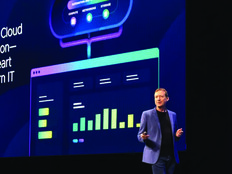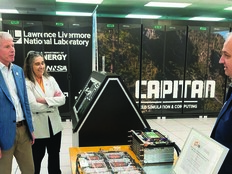Intelligence and defense agencies find they’re falling into a hybrid infrastructure model as they identify different compute solutions for the different missions they each have.
For instance, the National Security Agency uses a mix of Commercial Cloud Enterprise (C2E) solutions, its own instances of a top-secret cloud, Hardware as a Service and on-premises offerings.
The NSA’s much-anticipated Hybrid Compute Initiative went live earlier this year, and its focus is leveraging the best solutions industry has to offer to reserve its workforce for intelligence work.
“The long-term reasons why we made the shift are the increased reliability, increased performance, ultimate scalability and modularity, and the efficiency,” said Jennifer Kron, chief financial manager at the NSA, during a CIO panel at the 2024 DoDIIS Worldwide Conference in Omaha, Neb. “There was no way we could get where we needed to go in [signals intelligence] and cyber without those partnerships.”
Click the banner below to learn about advancing cloud deployments.
DISA’s Joint Operational Edge Effort Reaches Remote Warfighters
The Defense Information Systems Agency similarly relies on a variety of on-premises offerings and commercial cloud solutions at all classification levels by way of the Joint Warfighting Cloud Capability. Recently, DISA’s focus has been its Joint Operational Edge initiative.
“We’re actually deploying small clouds out closer to the edge, where our warfighters are essentially working around the world,” said Roger Greenwell, CIO at DISA.
The Department of Defense is working with its intelligence community partners to assess cloud risk and use in coordination with industry. The IC is taking the lead with top-secret cloud platforms and DOD with those at the secret level to avoid overlap.
That DOD’s risk tolerance differs from the IC’s in certain situations isn’t an issue, Greenwell says.
“The biggest thing is we’re trying to create those efficiencies and that shared knowledge by bringing the power of the two teams,” he says.
DOD is also looking at commercial cloud capabilities, particularly at the classified level, that will enable its coordination with the Five Eyes intelligence alliance and other coalition partners abroad.
The IC’s Endgame: AI-Enabled Hybrid Infrastructure
The National Geospatial-Intelligence Agency tried to move all of its workloads to the cloud by 2017, only to find that some needed to be moved back or left in its on-premises data center.
“Some workloads just don’t operate well for our mission of warning, safety and targeting in the cloud,” said Mark Chatelain, CIO at NGA.
But neither the cloud nor its data center could handle delivering capabilities to warfighters at the tactical edge. For that, NGA needed a truly hybrid solution.
“We have established something called joint regional edge nodes, which push data, push applications out to the edge, where analysts and warfighters sitting at the edge can actually access this information,” Chatelain said.
All of these efforts are building toward enabling artificial intelligence so that warfighters have better data insights faster than ever.
A total of five C2E vendors operate in the top-secret network fabric, paving the way for the CIA to go multicloud.
“Our imperative is to deliver the multicloud foundation to allow the community to take advantage of those higher-order services — whether they’re AI services natively provided by those vendors or a third party or open source — to have the compute capacity to run those models, to inference with cybersecurity data,” said Ryon Klotz, deputy CIO at the CIA.
To learn more about DoDIIS Worldwide, visit our conference page. You can also follow us on the social platform X at @FedTechMagazine to see behind-the-scenes moments.














